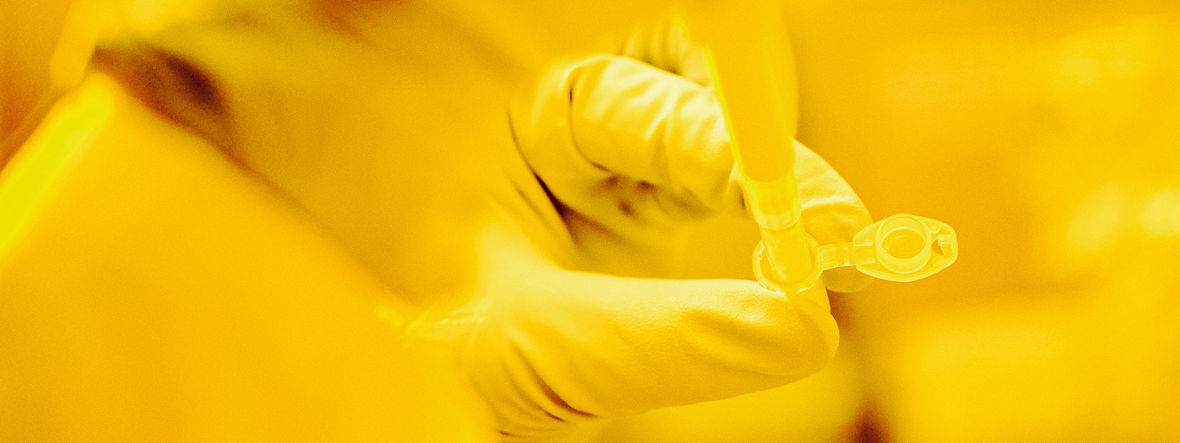Sometimes in science there are moments when things suddenly come together as if by magic. Thoughts and ideas that actually have nothing in common coalesce in a way that makes sense. That’s what happened over two years ago to a team led by the chemist Professor Holger Frey from the University of Mainz. For many years now, he has been experimenting with polyethylene glycol, a non-toxic “jack of all trades” compound among chemical substances.
Polyethylene glycol is a polymer—a long-chain molecule. Known as PEG for short, it is made up of ethylene oxide (EO) building blocks and is easily soluble in water. Its applications include ointments, shampoos, and a wide range of cosmetics. Many thousand tons of PEG are used for applications like these all over the world every year. But PEG also plays an important role in medicine. One such application is the delivery of active ingredients into the human body.
The chemists in Mainz were looking for a way to modify PEGs that would give them new characteristics and open up an even wider range of applications. Holger Frey’s postdoctoral researchers Rebecca Matthes and Philip Dreier were mainly focusing on a promising molecule that is very closely related to EO—glycidyl methyl ether, or GME for short. Like EO, GME can be used as starting material to form building blocks of polymers. And the two starting materials can be used in combination. The researchers from Mainz University created a polymer modified in this way, which they called rPEG. The “r” stands for “randomized,” because the EO and the GME building blocks are distributed at random throughout the chain during its manufacture. It’s interesting that all polymers made up of EO and GME building blocks are structural isomers. Compared with PEG, rPEG has additional molecular side chains, but is equally water-soluble. It also has other characteristics relevant for industrial applications.

Actually, the two researchers were not initially thinking about medical applications for rPEG at all. But suddenly various elements came together to form a picture: rPEG could present a breakthrough in the development of new types of mRNA therapeutics. Together with a research team from Evonik, Matthes and Dreier are now working to develop their discovery into a technology that can be used by the pharmaceutical industry. mRNA therapeutics are regarded as one of the most promising developments in medicine. They first demonstrated their effectiveness and potential as vaccines during the COVID-19 pandemic, when they were used at large scale. Experts anticipate that in the future mRNA therapeutics will be used to treat many other diseases that are difficult to treat today, such as multiple sclerosis and Alzheimer’s disease. Rare forms of cancer could also be combated with a mRNA therapy.
But so far there has been an obstacle: mRNA active ingredients are formulated with ultrapure special PEG lipids, among other substances, to ensure that they reach the target cells unscathed. However, it has been widely reported in literature that in rare cases PEG can trigger the formation of antibodies to PEG. Such reactions must be prevented in the future, especially for long-term applications, such as cancer therapeutics. As a result, the pharmaceutical industry has long been searching for alternatives to PEG.
Rebecca Matthes and Philip Dreier discovered exactly this kind of alternative—rPEG—just over two years ago. While Matthes and Dreier were working on the development of rPEG, several articles had been published in scientific journals describing how antibodies dock onto PEG and how the immune system recognizes PEG. “We immediately realized that our rPEG had the potential to prevent these immune reactions,” says Matthes. “We thought that we could prevent the docking of the antibodies with the additional molecular branches in the rPEG,” she explains. “That should make the modified PEG invisible to the immune system.”

A BREAKTHROUGH
The researchers followed up with extensive experiments. Over several weeks, they used GME and EO as starting materials to synthesize various new types of rPEG polymer structures. The research duo then brought the new polymer into contact with antibodies. And, as predicted, there was no interaction with the antibody at comparable concentrations.
THE FREY RESEARCH GROUP
Polymers are Holger Frey’s special field of expertise. His research group at the University of Mainz, where he has been teaching organic and macromolecular chemistry since 2002, deals with the synthesis, characterization, and applications of new functional polymers. Professor Frey (on the left) has been a co-publisher of the journal Polymer Chemistry since the fall of 2018. Dr. Rebecca Matthes and Dr. Philip Dreier wrote their Ph.D. dissertations under Frey’s supervision and are now doing postdoctoral work in his research group. There they are continuing to forge ahead with the development of rPEGs for a wide range of pharmaceutical applications.

The randomly distributed GME molecules’ side chains prevented the antibodies from binding to the rPEG. The Mainz researchers’ discovery could be very significant for the pharmaceutical industry. PEG lipids are among the most important ingredients of the lipid nanoparticles (LNPs) that are used to package mRNA active ingredients. LNPs are tiny spherical ferries that transport the active ingredient through the body into the cells. These delivery vehicles are needed because mRNA is extremely unstable and requires protection.
LNPs are similar to drops of fat in water. These nanometer-scale droplets of fat comprise a carefully designed combination of various lipids. The PEG chains are located at the surface of the LNP. They stabilize the particle and avoid recognition by the immune system. The hydrophobic fatty acid chains of the lipid protrude inwards. The mRNA is located inside the LNPs.
“After we realized that rPEGs can be used to prevent the formation of antibodies to PEG, we approached industry,” says Frey. That’s when he got in touch with Evonik. He knew that during the peak phase of the COVID-19 pandemic Evonik researchers had successfully produced important components for the vaccines from BioNTech/Pfizer—including customized specialty lipids. “When I told the Evonik researchers about our rPEG, they were immediately enthusiastic,” Frey says.

»When I told the Evonik researchers about our rPEG, they were immediately enthusiastic«
Holger Frey PROFESSOR OF CHEMISTRY AT THE UNIVERSITY OF MAINZ
The Evonik researchers took on the task of conjugating the rPEG from Mainz to lipids and using the resulting compounds to develop functional LNPs. “We had the huge advantage that we could tap into existing resources in Hanau and Dossenheim for the synthesis and characterization of customized lipids,” says Dr. Thomas Endres, who heads the project at Evonik. He formed a project team that brought together experts from several units—especially from the synthesis laboratory in Hanau and the formulation and cell culture laboratories in Darmstadt.
The initial aim was to link the rPEG from Mainz with fat-soluble molecule segments to a lipid. Erich Kraus, a member of the lab team in Hanau, tested various conditions in small glass reactors. He varied the reaction temperature and the concentration of the individual reagents and the solvents, removed unwanted byproducts, and isolated the product.

INDUSTRIAL PRODUCTION ON A MINI-SCALE
“The first trials were sobering, with a yield of only about 30 percent of the desired rPEG lipid,” reports Dr. Ulrich Klöckner, who heads the work in Hanau. It quickly became evident that the functional end of the rPEG molecule had to be modified to increase chemical reactivity. “Our colleagues in Mainz solved that problem very quickly,“ Klöckner adds. Using the modified molecule, the team in Hanau is now reporting yields of more than 70 percent. This is also important for potential industrial production, because a chemical process is cost-effective and sustainable only if a large proportion of the raw materials is converted into the desired end product. Currently, the researchers in Hanau are working to make the production process of the rPEG lipid even more efficient.
Many chemical products are produced by the ton. Quantities of LNPs and mRNA-based vaccines or medications are minute in comparison. The COVID-19 vaccine Comirnaty from BioNTech/Pfizer contains only 30 micrograms of mRNA. One vaccination dose has a volume of 0.3 milliliters. A 300-liter container would be big enough to hold vaccine doses for millions of people.

At the Evonik lab in Darmstadt, Melanie Liefke uses the rPEG lipids and other components to produce the LNPs that are needed for further tests. Sitting at the laminar flow cabinet, she uses pipettes to precisely add doses of various liquids—rPEG lipids, three other lipids, and mRNA—to a thimble-sized plastic cap. Thanks to her experience and skill, she can produce functional LNPs in the desired sizes. “You have to mix the components quickly and gently, because the mRNA is very sensitive,” she explains.

Well-structured LNPs are formed during the controlled mixing. This is partly because the mRNA, the rPEG lipid, and the other components assemble automatically, explains the molecular biologist Dr. Anne Benedikt, the head of the cell culture laboratory in Darmstadt. “This is because the material is self-organizing,” she says. “For example, the fatty acids avoid water, and we can predict how the units assemble driven by their electric charge.” The real challenge in handling mRNA lies in the fact that it can be degraded if the work is not performed in an ultraclean environment, she adds. “That’s because we humans have enzymes on our skin that quickly degrade foreign mRNA—it’s our innate protection system,” Benedikt explains. Researchers who work with mRNA in a laboratory therefore need to make sure the environment is ultraclean and free of these enzymes.
BIOLOGY AND CHEMISTRY ARE NEXT-DOOR NEIGHBORS
The LNPs are not only produced but also tested in Darmstadt. The team is investigating the interaction of LNPs with living cells. Katrin Häfner, a senior scientist at the cell culture laboratory, points to a transparent plastic microplate under the laminar flow cabinet. The panel has indentations that are filled with a liquid. In some the liquid is rather orange, in others it’s purple. “In this test we determine the highest concentration of LNPs that the cells can tolerate,” she says.

Next door, researchers are investigating whether the LNPs are successfully delivering mRNA into the target cells. To do this, they are using special test systems that emit a dim light if the mRNA has been successfully transferred and if the transfer has been followed by the production of the target protein. The light is detected by a sensor. The better the carrier system performs, the brighter the light.

Endres, the project leader, is proud of what has been accomplished so far. “We have demonstrated that rPEG can be used to produce fully functional LNPs that deliver mRNA effectively under cell-culture conditions,” he says. Moreover, this was accomplished quickly. “We went from the initial idea to a successful proof of concept in only one year,” he explains, adding that research and development in the pharmaceutical sector is complex and time-consuming, often requiring many years of work.
ON THE WAY TO INITIAL TESTS
Endres says that the beauty of the technology lies in the similar properties of rPEG and PEG. “rPEG blends seamlessly into industrial production processes,” he adds. Other research groups all over the world are trying to replace PEGs with other water-soluble macromolecules in order to avoid antibody formation. However, these macromolecules were chemically so different from PEG that development of completely new production processes would be needed.

Another factor that promoted speed was the complementary expertise from both partners. “Together we cover the entire value chain from basic research to lipid production on a commercial scale under quality oversight,” Endres says. The University of Mainz and Evonik also want to take the next step together. The LNPs made with the rPEG lipids must undergo further tests before the researchers can start thinking about applications in humans. If these tests are also successful, Evonik can offer pharmaceutical companies the rPEG lipids as a product and the LNPs based on them as a formulation option for mRNA active ingredients. According to Endres, “This would be an ideal addition to our portfolio.”
During the peak phase of the COVID-19 pandemic, the magazine Der Spiegel devoted a long feature article to lipid nanoparticles and mRNA therapies. The article even speaks of a “magic bullet.” Thomas Endres doesn’t want to go quite that far. However, he’s convinced of one thing: that rPEGs have the potential to make future mRNA medications better with an improved safety profile.


